Optimized Rear Drive Torque Allocation Strategy for Dual-Motor Mining Dump Trucks
Abstract
:1. Introduction
2. Distribution Strategy of Base Torque and Compensation Torque for Dual Motors
2.1. Calculation of Base Torque
2.2. Compensating Torque Calculation
3. Torque Allocation Strategy Based on Particle Swarm Optimization Algorithm
3.1. Dual-Motor Torque Distribution Input Power Model
3.2. Torque Allocation Method Based on Particle Swarm Optimization Algorithm
3.3. Optimization Results of Torque Distribution Coefficients for the Dual Motors
4. Simulation Results Analysis of Optimal Torque Allocation Strategy for Dual Motors
4.1. Analysis of Particle Swarm Optimization Results Based on Simulink
4.2. Performance Simulation Based on CRUISE under Different Working Conditions
5. Conclusions
Author Contributions
Funding
Data Availability Statement
Conflicts of Interest
References
- Wang, C.; Guo, C.; Tsay, D.; Perng, J.-W. PMSM speed control based on particle swarm optimization and deep deterministic policy gradient under load disturbance. Machines 2021, 9, 343. [Google Scholar] [CrossRef]
- Wei, H.; Zhang, N.; Liang, J.; Ai, Q.; Zhao, W.; Huang, T.; Zhang, Y. Deep reinforcement learning based direct torque control strategy for distributed drive electric vehicles considering active safety and energy saving performance. Energy 2022, 238, 121725. [Google Scholar] [CrossRef]
- Qiao, S. Optimal Torque Distribution Strategy of Dual-Motor Four-Wheel-Drive Pure Electric Vehicle Based on the Efficiency Characteristics of Key Components. Master’s Thesis, Chongqing University, Chongqing, China, 2020. [Google Scholar] [CrossRef]
- Qi, X.; Wang, Q.; Chen, L.; Cao, J.; Zhang, Q.; Li, G. Optimization strategies of torque distribution for front and rear dual motor driven electric vehicles. Electr. Mach. Control 2020, 24, 62–70. [Google Scholar] [CrossRef]
- Zeng, J. Study on Drive Control Strategy for a Novel Dual-Motor Coupling Powertrain. Master’s Thesis, Chongqing University, Chongqing, China, 2015. [Google Scholar]
- Wang, W.; Shi, J.; Zhang, Z.; Lin, C. Optimization of a dual-motor coupled powertrain energy management strategy for a battery electric bus. Energy Procedia 2018, 145, 20–25. [Google Scholar] [CrossRef]
- Hu, J.; Niu, X.; Jiang, X.; Zu, G. Energy management strategy based on driving pattern recognition for a dual—Motor battery electric vehicle. Int. J. Energy Res. 2019, 43, 3346–3364. [Google Scholar] [CrossRef]
- Mu, B.; Ye, X. Research on model predictive control strategy based on dynamic planning. Heavy Truck 2023, 6, 6–8. [Google Scholar]
- Pan, C.; Yao, L.; Lai, J.; Cai, C.; Chen, X. Control Strategy of Dual-motor Nutation Coupling Drive System for Electric Bus. J. Mech. Transm. 2021, 45, 42–52+66. [Google Scholar]
- Ye, L.; Wu, Z.; Lv, W. Optimisation of braking energy recovery for rear-drive electric vehicles based on fuzzy control. Int. J. Veh. Des. 2023, 92, 93–112. [Google Scholar] [CrossRef]
- Wang, Y.; Qiao, M. Research on Driving Torque Optimization Control Strategy of Pure Electric Mine Car Based on Load Variation. Automob. Technol. 2023, 48, 36–42. [Google Scholar] [CrossRef]
- Li, J.; He, R. Energy management strategy of drive mode for dual-rotor in-wheel motor driven electric vehicle based on optimal system efficiency. J. Jilin Univ. (Eng. Technol. Ed.) 2024, 1671, 1–11. [Google Scholar] [CrossRef]
- Lin, Y.; Huang, Q.; Zhang, G. Torque Distribution Strategy Optimization of a Novel Dual-Motor Multi-Mode Drive System Using PSO Algorithm. Automot. Eng. 2022, 44, 1218–1225. [Google Scholar] [CrossRef]
- Li, B.; Zeng, L. Position Decoupling Control of Rigid Rotor of Active Magnetic Bearing. Mechanika 2023, 29, 292–301. [Google Scholar] [CrossRef]
- Ju, F.; Du, W.; Zhuang, W.; Li, B.; Wang, T.; Wang, W.; Ma, H. Profit-Effective Component Sizing for Electric Delivery Trucks with Dual Motor Coupling Powertrain. Energy. 2024, 296, 131055. [Google Scholar] [CrossRef]
- Xu, X.; Wang, Y.; Wang, Y. Influence of magnetic field on sound transmission loss of Magnetorheological fluids. Materials. 2022, 15, 6032. [Google Scholar] [CrossRef] [PubMed]
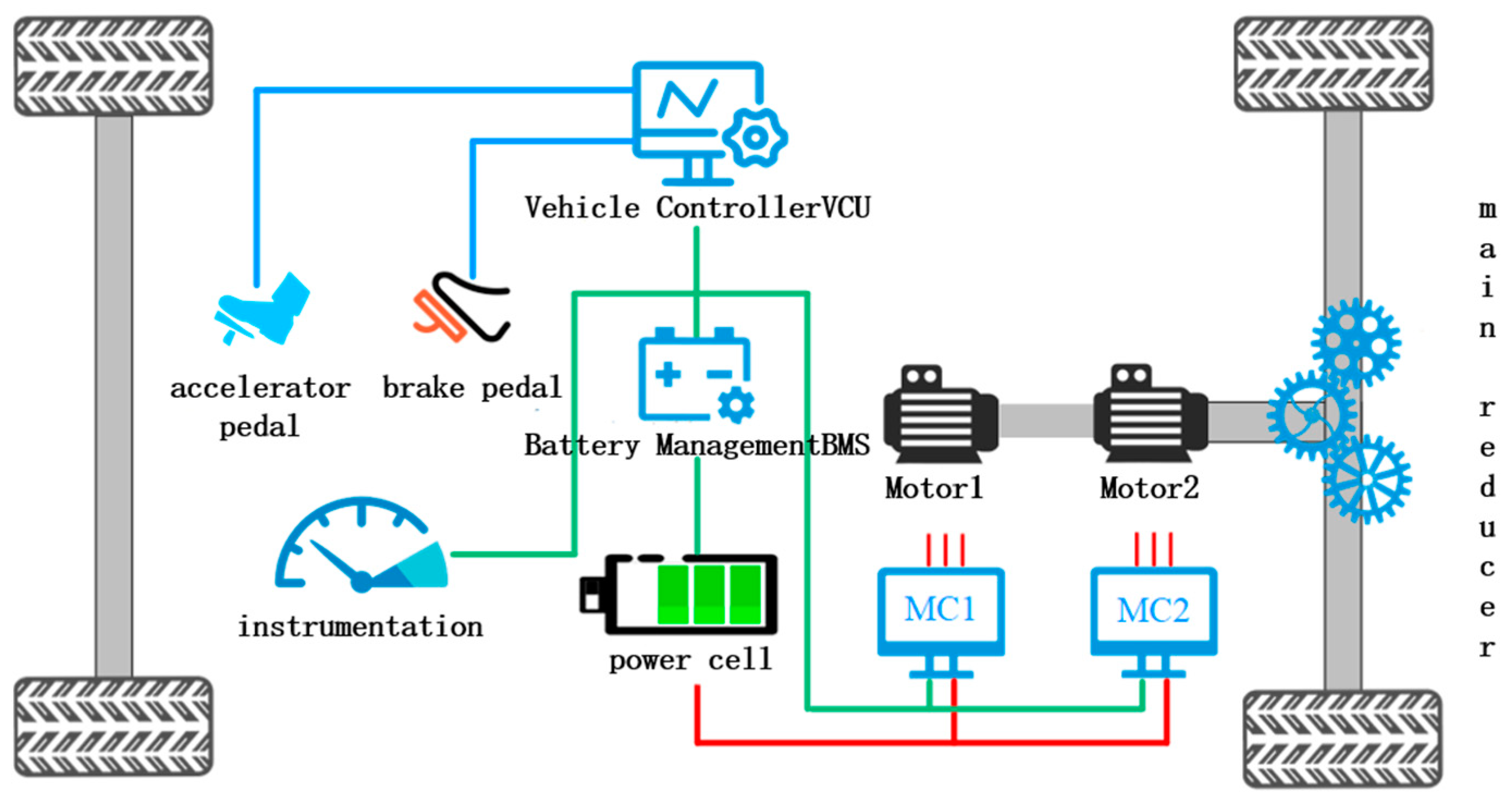
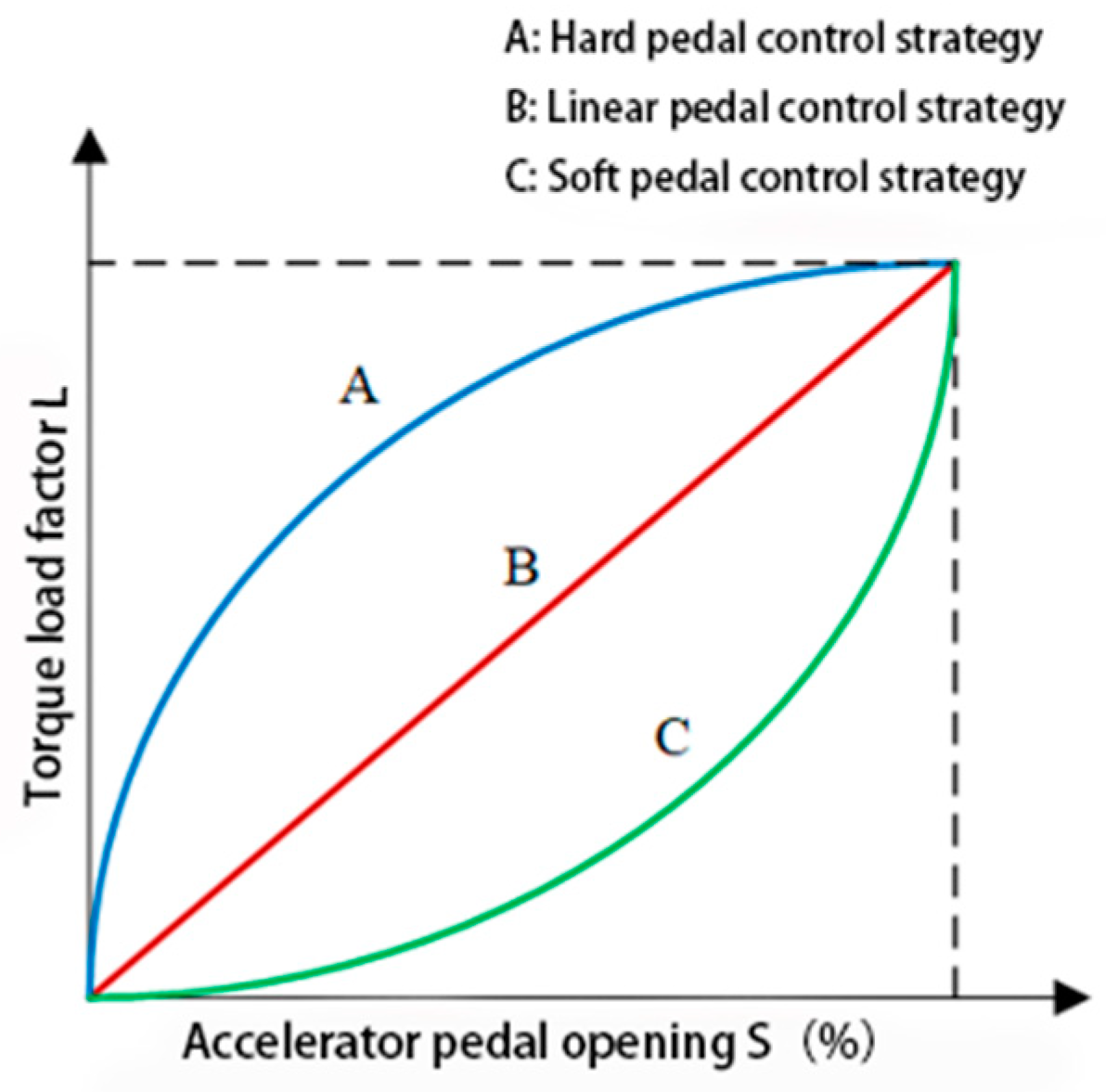
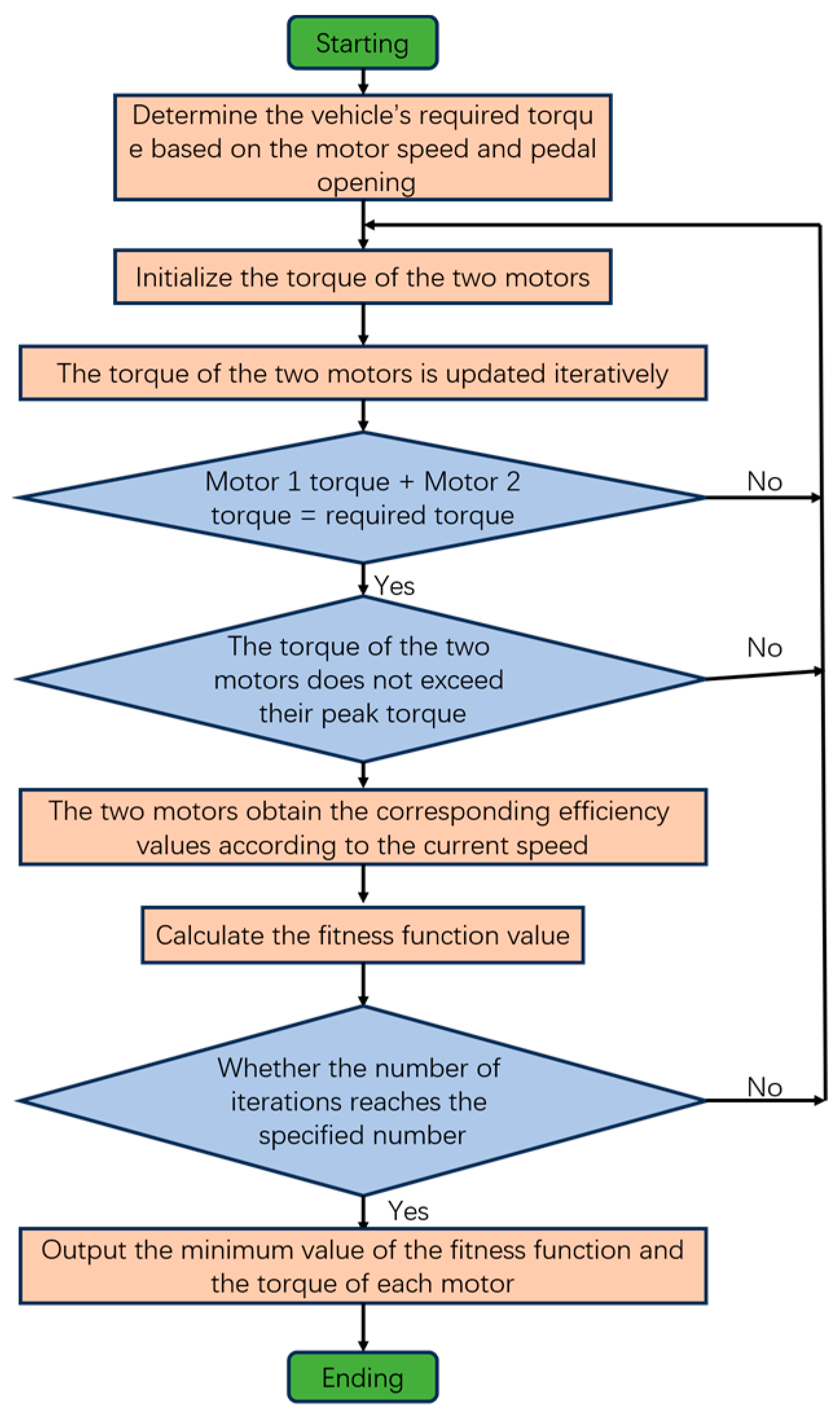

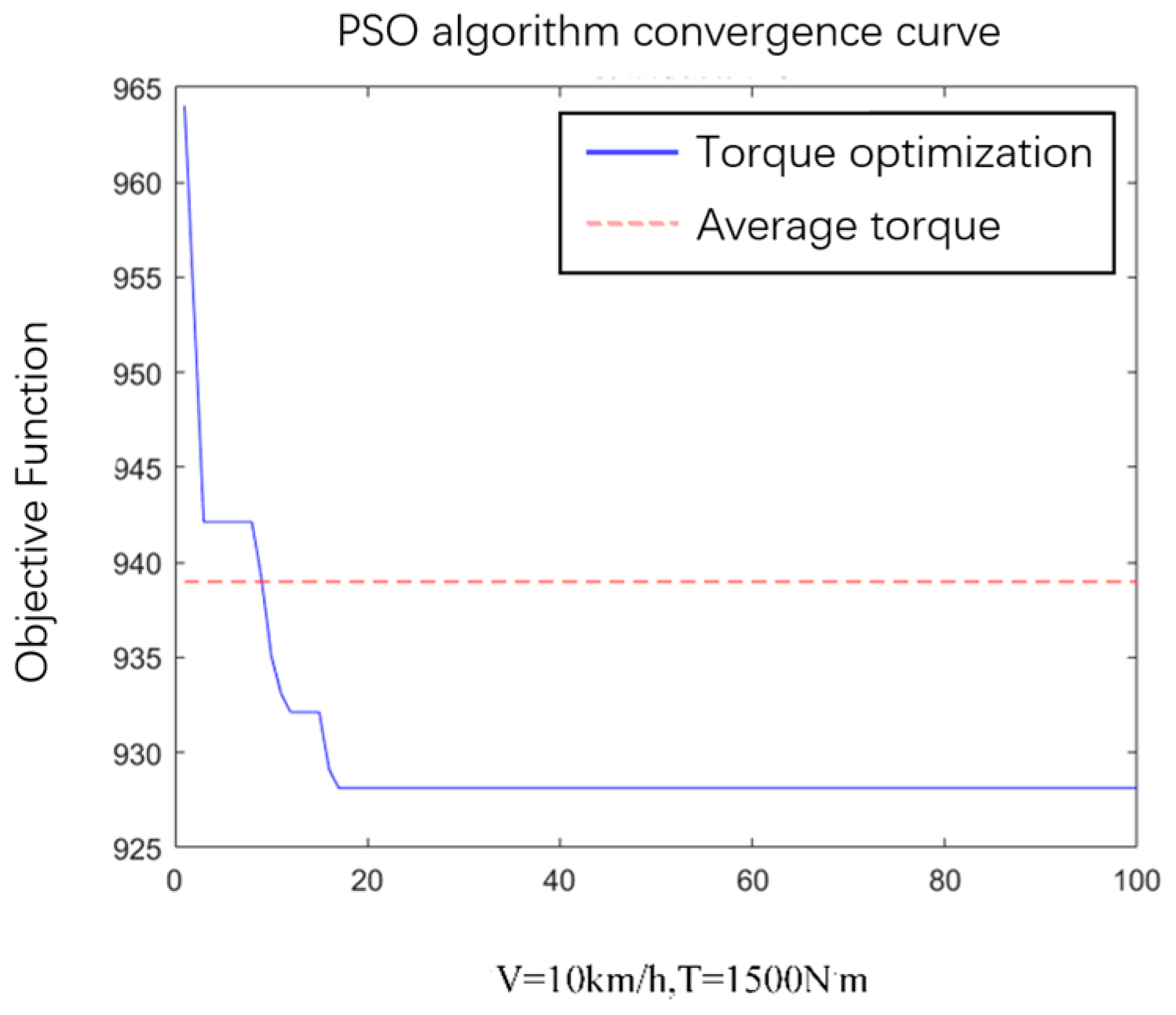
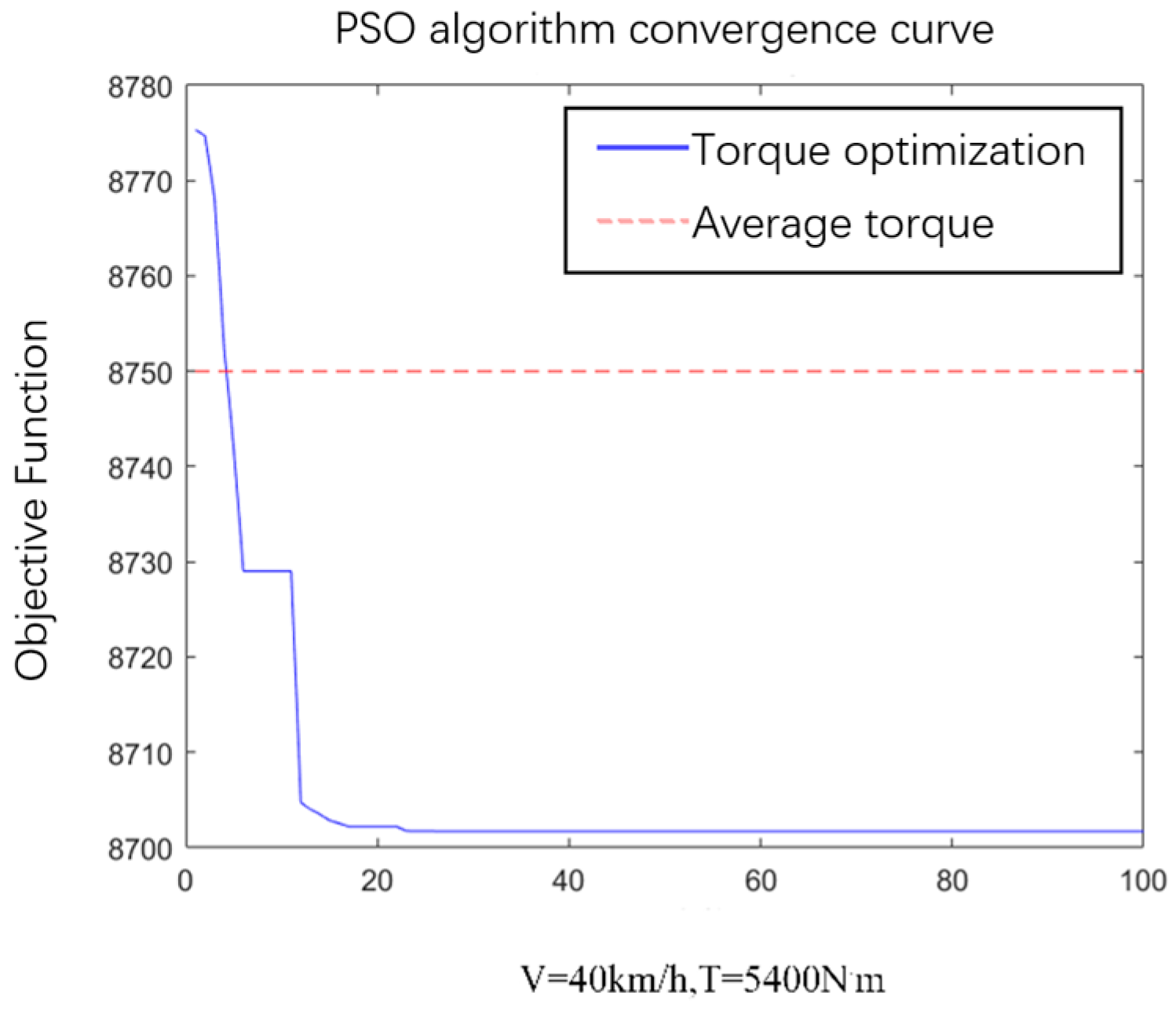



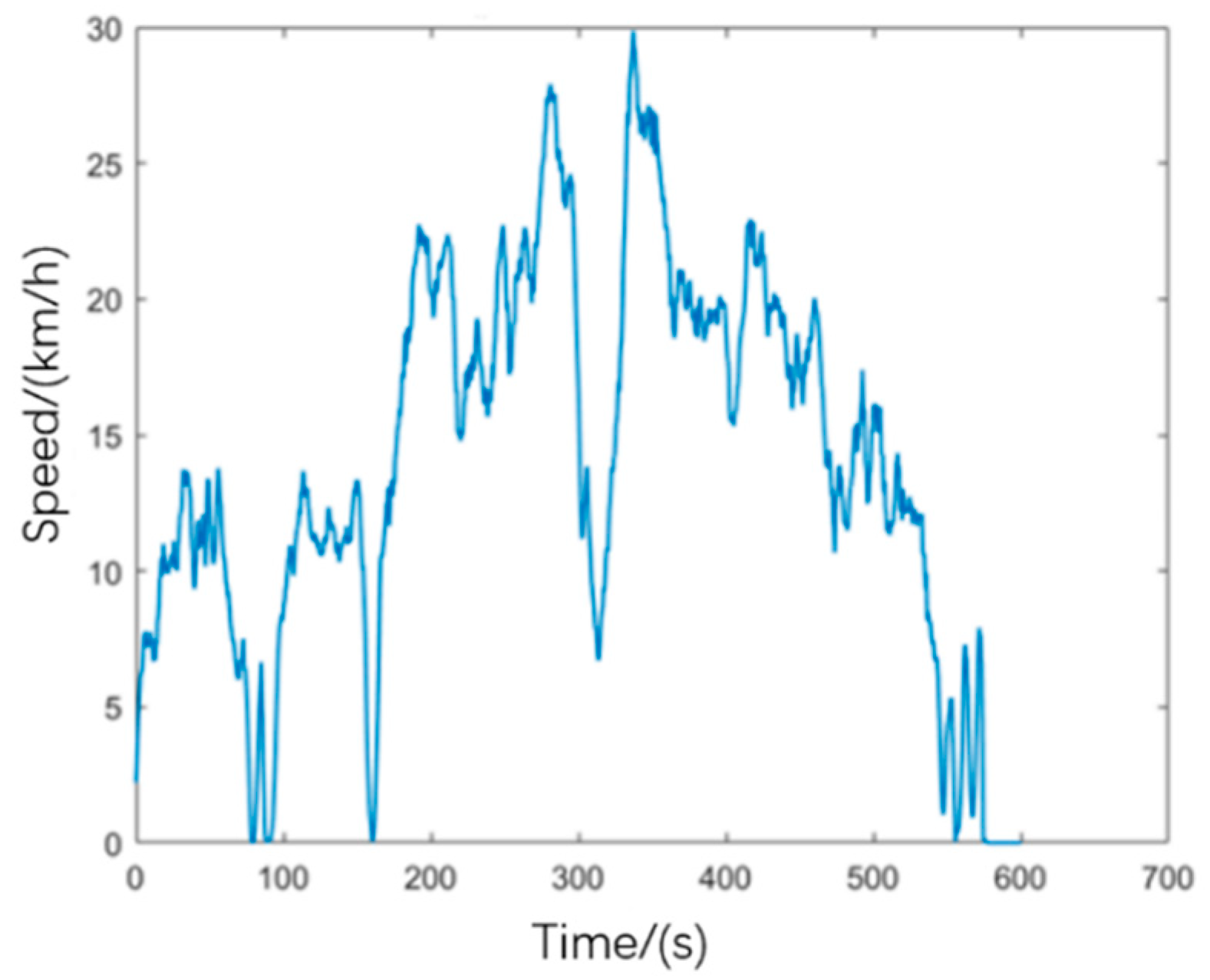

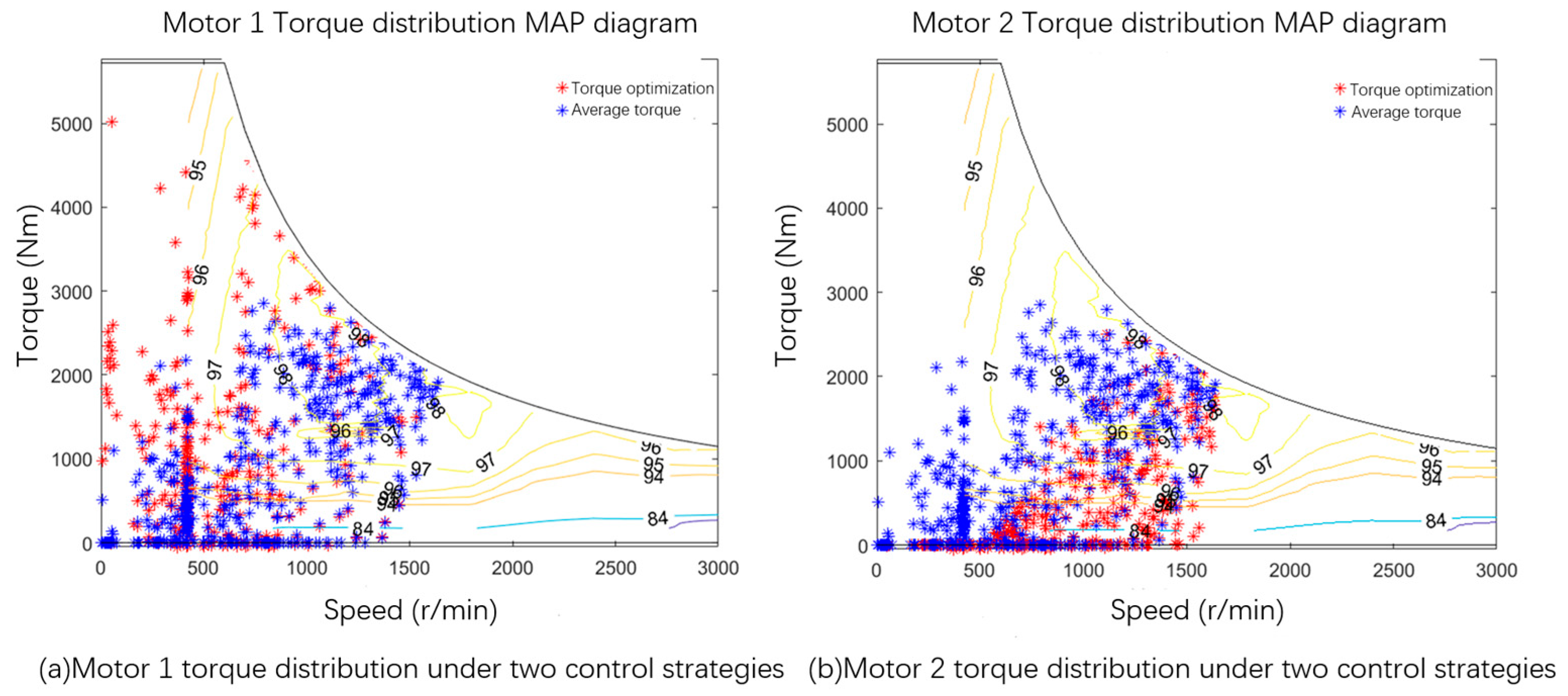
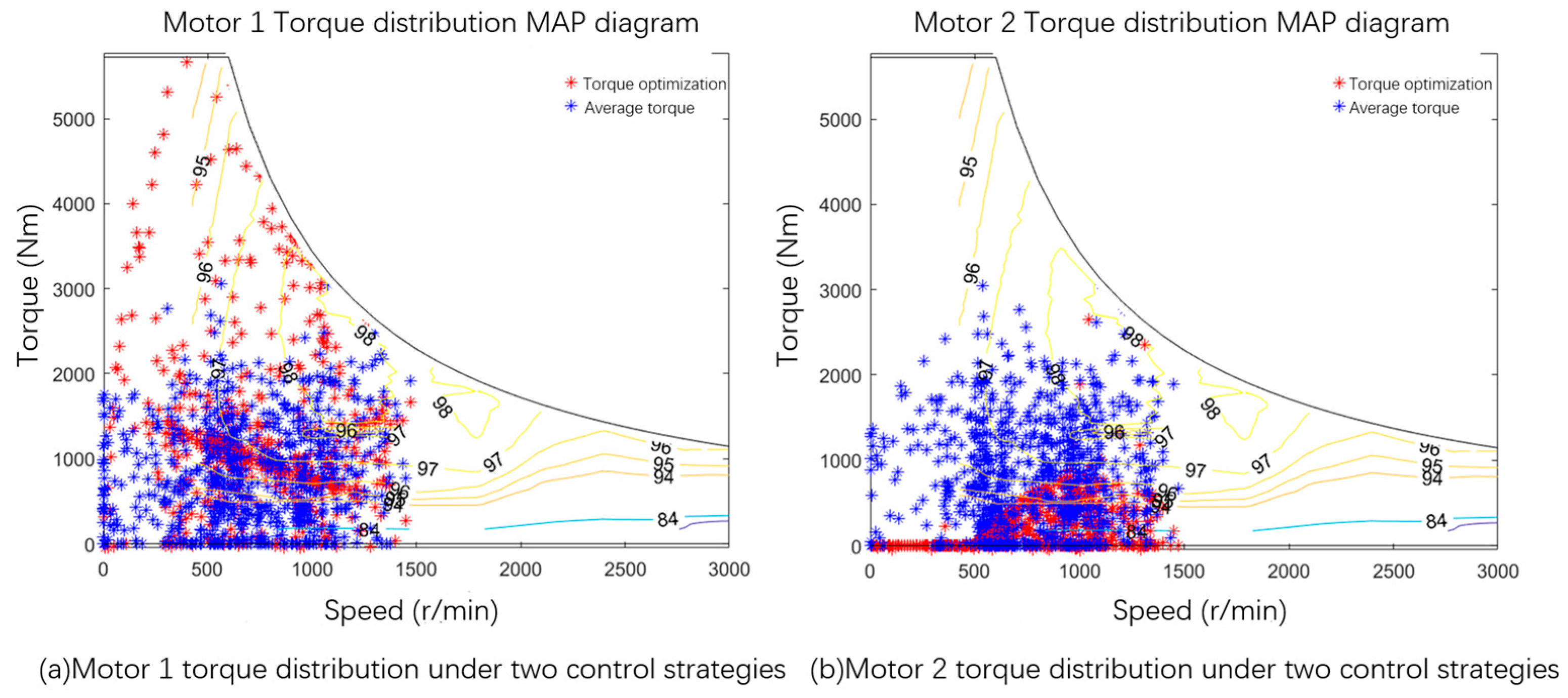


| Motor Parameters | Numeric | Motor Parameters | Numeric |
|---|---|---|---|
| Rated power (kW) | 250 | Rated voltage (V) | 600 |
| Peak power (kW) | 360 | Rated frequency (Hz) | 84.88 |
| Rated torque (N·m) | 2700 | Rated current (A) | 580 |
| Peak torque (N·m) | 5720 | Peak current (A) | 1120 |
| Rated speed (r/min) | 900 | Cooling method | Water Cooling |
| Peak speed (r/min) | 3000 | Protection level | IP67 |
| Project | Parameter Name | Numeric |
|---|---|---|
| Basic parameters of the vehicle | Overall dimensions (length × width × height) (mm) | 8875 × 4270 × 4345 |
| Curb weight m0 (kg) | 35,000 | |
| Full load mass ma (kg) | 80,000 | |
| Wheelbase L (mm) | 3960 | |
| Fully loaded center of mass height hg (mm) | 1970 | |
| Axle load distribution in no-load state | forward: 48%, back: 52% | |
| Axle load distribution at full load | forward: 34%, back: 66% | |
| Windward area A (m2) | 17.24 | |
| Air resistance coefficient CD | 0.8 | |
| Wheel rolling radius r (mm) | 960 | |
| Rolling resistance coefficient f | 0.03 |
| SOC (%) | Speed (km/h) | Accelerator Pedal Opening Rate (%) | ||
|---|---|---|---|---|
| S | M | B | ||
| S | S | S | M | M |
| S | M | S | S | M |
| S | B | S | S | M |
| M | S | S | M | B |
| M | M | S | M | B |
| M | B | S | S | M |
| B | S | M | B | B |
| B | M | S | M | B |
| B | B | S | M | B |
Disclaimer/Publisher’s Note: The statements, opinions and data contained in all publications are solely those of the individual author(s) and contributor(s) and not of MDPI and/or the editor(s). MDPI and/or the editor(s) disclaim responsibility for any injury to people or property resulting from any ideas, methods, instructions or products referred to in the content. |
© 2024 by the authors. Licensee MDPI, Basel, Switzerland. This article is an open access article distributed under the terms and conditions of the Creative Commons Attribution (CC BY) license (https://creativecommons.org/licenses/by/4.0/).
Share and Cite
Chen, Y.; Wang, Z.; Pan, Z.; Zheng, Y. Optimized Rear Drive Torque Allocation Strategy for Dual-Motor Mining Dump Trucks. Machines 2024, 12, 613. https://doi.org/10.3390/machines12090613
Chen Y, Wang Z, Pan Z, Zheng Y. Optimized Rear Drive Torque Allocation Strategy for Dual-Motor Mining Dump Trucks. Machines. 2024; 12(9):613. https://doi.org/10.3390/machines12090613
Chicago/Turabian StyleChen, Yuzhou, Zheyun Wang, Zhengjun Pan, and Yanping Zheng. 2024. "Optimized Rear Drive Torque Allocation Strategy for Dual-Motor Mining Dump Trucks" Machines 12, no. 9: 613. https://doi.org/10.3390/machines12090613
APA StyleChen, Y., Wang, Z., Pan, Z., & Zheng, Y. (2024). Optimized Rear Drive Torque Allocation Strategy for Dual-Motor Mining Dump Trucks. Machines, 12(9), 613. https://doi.org/10.3390/machines12090613






